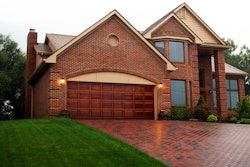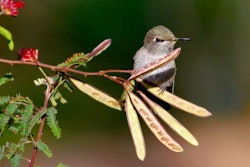 Photo: Perfect Grass
Photo: Perfect GrassThe California drought may be over but the artificial turf that homeowners have installed is here to stay.
Certified manufacturers won’t guarantee synthetic grass to last more than eight years, but the Synthetic Grass Warehouse says that high quality artificial turf can last anywhere from 10 to 15 years, depending on the wear and tear.
While most homeowners opt for synthetic turf to cut down on water usage or maintenance requirements, the fact remains that this iteration of greenery is not without its own set of maintenance needs.
Once your client has realized that low maintenance certainly doesn’t mean no maintenance, you can share with them what care is needed to help the product last as long as possible.
Depending on the homeowner’s situation, they will need to clean the synthetic turf far more often if they have pets or children compared to those who do not. Those who live in dusty regions will need to rinse their lawn more often while those in rainy regions can let the stormwater wash off their lawn.
To clear away debris, dust and dirt, a lawn sweeper, garden vacuum or a leaf blower can be used to keep the lawn tidy. A light rinse with the garden hose can also wash away dust and pollen that has accumulated. This level of maintenance can be done as needed or on a weekly basis.
On a monthly basis, artificial turf lawns will need some proper grooming to ensure that the grass blades stand upright and don’t become matted. A stiff brush, ideally one with synthetic bristles at least 5 inches long, can be used to fluff the turf back up to its standing state. Never use a brush with metal or wire bristles as these can damage the turf fibers.
If the installed artificial grass is over an expansive area, focus on areas of high traffic and keep in mind, the more frequent the foot traffic the more often brushing will be needed.
 Photo: Perfect Grass
Photo: Perfect GrassFor the pet owners, cleaning artificial turf isn’t that challenging. Solid pet waste should be removed by their preferred method either with a pooper scooper or a plastic bag and then the former location of the waste should be hosed down.
Pet urine areas should be sprayed down at least one time each week. It is important to note that synthetic turf installations with pets in mind are different than typical installations as they include a turf deodorizer on the top of the base layer to neutralize the ammonia smell of pet urine.
If a customer got a pet after they had their synthetic turf installed, it is a better idea to create a separate bathroom area for the pet to use. These spaces can be made of pea gravel or other easy-to-clean hardscaping materials.
For other spills and stains that could occur during backyard activities, most can be rinsed away with water. If residue remains, a mixture of mild soap and warm water can do the trick as well as a half-and-half solution of vinegar and water.
Certain materials such as grease, lubricants and motor oil can damage or discolor the turf, so it is important to avoid spilling these substances, but mineral spirits can be used sparingly to clean the spots.
Even though weeds are less likely to appear through synthetic grass backing, some still can wriggle through so these can either be hand pulled or sprayed with weed killer.
Artificial turf can get particularly hot in the summer, but newer products are coated to deflect the heat. Also, the turf can be wetted with a hose or sprinkler to cool it down for a bit.
In snowy regions, if there is a light dusting of snow simply wait for it to melt, but if there are several inches or feet of snow it can be shoveled with a plastic snow shovel. If the snowfall was particularly heavy, the lawn may need a touchup with a broom after the snow has melted.
If this all sounds like too much for the client, you can always offer your skills at professionally rejuvenating and cleaning the synthetic turf so it can last for as long as possible.









